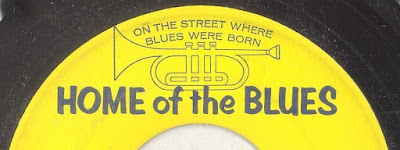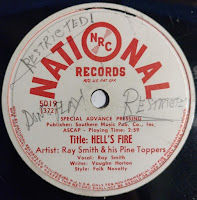Home of the Blues Records
On the Street Where Blues Were Born
I recently made contacts with ancestors of Ruben Cherry and Celia Camp, owners of the Home of the Blues label, a mostly overlooked Memphis record label. Both Cherry and Camp were influential figures in the city's music scene, though they are forgotten nowadays. During its years active in the 1960s, the Home of the Blues label released recordings mostly in the rock’n’roll and rhythm and blues genres. The label was active from 1960 until 1964 and had only limited commercial success.
Though it was part of the development of southern soul music and an early nest of this music's forerunners.
The Beginnings
The Home of the Blues record label was founded by Ruben Cherry, who also operated the Home of the Blues record shop. Cherry, a native Memphian born there in 1923, had opened the shop in the mid 1940s after World War II and soon, it became a music institution in the city. Cherry was known for his eccentric behavior and colorful appearance. Located on Beale Street, which is still the city’s amusement alley with countless juke joints and bars featuring live blues music, the shop was named aptly “Home of the Blues” (with its slogan “on the street where blues were born”). Soon, it developed into a music hot spot for both black and white customers as the shop offered all kinds of musical genres. Some of the now famous personalities that entered Cherry’s store frequently were local DJ Dewey Phillips, Elvis Presley, Johnny Cash (who also composed his song “Home of the Blues” inspired by the shop), or members of the Johnny Burnette Trio, including guitarist Paul Burlison.
The Home of the Blues Record Company, as it was officially called, was founded on July 15, 1960, by Cherry and Camp, both being owners of the company. While Cherry was responsible for the creative part of the business, which included spotting and signing recording artists, Camp took care of the financial issues of the company. Though sharing the name, the record shop and the record label were separate businesses operated by Cherry (and Camp). Other people involved in the label were Arthur Baldwin as vice president, Max Goldstein as vice president of sales, Ray Meaders as promotion man, and Wolf Lebovitz, who joined the label as a company secretary, dealing also with some of its partner labels. Lebovitz was married to Celia Camp’s adopted niece Dorothy.
The Artists - The Recordings
The first artist to record for Home of the Blues was R&B singer Roy Brown, who had cut numerous discs for several labels before. His “Don’t Break My Heart” b/w “A Man with the Blues” (HOTB #107) appeared already in July 1960. Although Brown had been a successful singer with several chart hits in the 1940s, his debut for the Home of the Blues label did not reach the charts. Brown had a total of four releases on the label and in Brown’s own memory, his third single, a duet with Mamie Dell called “Oh So Wonderful” from early 1961, sold well at least locally. According to Brown, around 44,000 copies were sold in Memphis but due to missing distribution, failed to sell outside of the city.
By August, another singer had been signed to the label, namely Dave Dixon, whose recordings “You Satisfy” and “You Don’t Love Me No More” (HOTB #108) were released the same month but did not sell better than its precursor.
What became probably the label’s biggest success in commercial terms was a song by the 5 Royales, another R&B act that had enjoyed successful years in the early 1950s while recording for Apollo Records. Their “Please, Please Please”, released with the flip side “I Got to Know” (HOTB #112) in October the same year, reached #114 on Billboard’s “Bubbling Under” chart.
From 1960 until 1962, more artists recorded for the label and many of them were influential musicians in the blues and R&B fields. Larry Birdsong, Willie Mitchell (who made his first attempts as a producer for Cherry), and Willie Cobbs were some of them. Billy Lee Riley, who had recorded rockabilly for Sun Records in the 1950s, recorded a single for the label in 1961, as did Billy Adams, another former Sun recording artist.
By 1961, Cherry and Camp had worked out an agreement with the Vee-Jay record label to release Home of the Blues material also on the Vee-Jay label for national distribution. This deal soon transferred to ABC-Paramount Records after the company purchased Vee-Jay. However, the output of Home of the Blues material on its partner companies remained very limited and did not add any success.
Cherry and Camp created a couple of subsidiary labels, including Rufus Records, Six-O-Six Records, 1st Records, and Zab Records. Only few singles were released on these off-shots and they remained without commercial success.
Demise
The label’s last release came nearly exactly two years after its debut in August 1962 with Jimmy “Louisiana” Dotson’s “Search No More” b/w “I Feel Alright” (HOTB #244). After a two years existence without a major chart hit, the Home of the Blues label came to an end. There could have been more recording sessions during 1963 and 1964 - and there were a few copyright registrations - but apparently the label did not release any new singles.
Around the same time, Celia G. Camp had divorced from her first husband Clarence Camp but had remarried a man by the name of Ward Hodge a year later. Hodge in turn was the manager of a female teenage singer, who recorded for the company’s 1st Records subsidiary when she was still underage. According to local Memphis part-time music historian John Shaw, the singer’s parents sued Ward and Celia Hodge, which – according to Shaw – “may have occasioned the label's closing”.
Cash Box magazine reported on November 24, 1967, that Ruben Cherry had moved his Home of the Blues record shop from Beale Street to 147 South Main Street due to urban renewal in Downtown Memphis. Three years later, in 1970, Celia Camp sold the Home of the Blues label, catalog and recording tapes to Wayne McGinnis’ Memphis Record Company. Unfortunately, the Home of the Blues master tapes were stolen from McGinnis’ office and have not turned up since. Ruben Cherry died in 1976 at the age of 52 years in Memphis. Celia Camp passed away in 1979. After their deaths, Wayne McGinnis in turn sold the company to British music enthusiast and entrepreneur Dave Travis in 1991.
In recent years, confusion has been raised to who the rightfully owner of the Home of the Blues material is. Steve LaVere, who is considered to be a rather dubious character in music business, claimed to have the rights to the label. As it turned out, Wolf Lebovitz, who was in the possession of numerous unreleased Home of the Blues tapes, assigned the rights to LaVere. Although LaVere managed to transfer the song catalog to his Delta Haze publishing firm before he died, Dave Travis had already bought the Memphis Music Company, including the Home of the Blues label, from Wayne McGinnis, emphasizing that his deal was legally set up with the person who inherited the rights to the label.
 |
| Home of the Blues sign in Memphis, 2023, marking the beginning of Beale Street. The name "Home of the Blues" was adopted by the city of Memphis for marketing purposes. |
Legacy
In contrast to other Memphis labels, the Home of the Blues label had been of little interest to reissue record companies and scholars in the past. In 1995, the Japanese P-Vine label released three CDs with Home of the Blues material. The British Stomper Time label, known for various reissue albums of Memphis music, released another two CDs containing Home of the Blues recordings. Most recently, German Bear Family Records has released two 10-track LPs with Home of the Blues material in 2021. The label is briefly mentioned at Memphis’ Stax Museum of American Soul Music as well as the Rock’n’Soul Museum, also located in the city.
While the Home of the Blues record label did not gain much national chart success, the recordings of the label bridged the gap between Rock ‘n’ Roll, Rhythm and Blues, and the development of Soul music in Memphis, Detroit and Philadelphia. However, it was probably Ruben Cherry’s record shop that had a much deeper impact on the musical education of many influential Memphis musicians, including B.B. King, Elvis Presley, and Johnny Cash. The latter not only borrowed the Home of the Blues name as a tribute for one of his songs, but also acknowledged the shop as an influence on him during his 1992 Rock and Roll Hall of Fame induction speech.
The Congress of the United States, in a motion brought by Rep. Steve Cohen, designated the phrase “Home of the Blues” to the city of Memphis, which uses it as the city’s nickname and slogan for music tourism promotion. It is also used for Beale Street and can be seen on the gates marking the street.
• Howdy at his 45 blog has also two songs by Larry Birdsong on Home of the Blues. See here and here.
Sources
• 45cat entry
• Ruben Cherry Find a Grave entry
• Tony Wilkinson: "Home of the Blues Label and Record Shop Story" (American Music Magazine #133), 2013
• Thanks to Bruce Frager, a relative of Ruben Cherry and Celia Camp, for providing additional material and for keeping the memory of Home of the Blues Records alive!

























